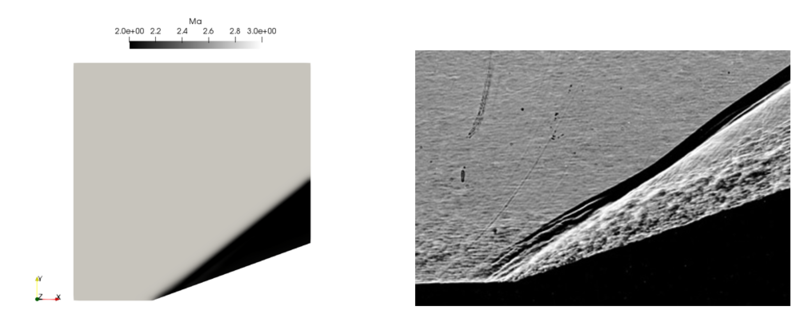Difference between revisions of "Compressible flows by Joel Guerrero"
Jump to navigation
Jump to search
| (8 intermediate revisions by the same user not shown) | |||
| Line 8: | Line 8: | ||
| − | =[http://www.wolfdynamics.com/ | + | =[http://www.wolfdynamics.com/validations/supersonic_wedge/tut_2D_supersonic_wedge.pdf Supersonic flow past a wedge - Shock waves]= |
| − | [[File: | + | [[File:sup_wedge.png|800px|right|Supersonic wedge]] |
| − | In this [http://www.wolfdynamics.com/ | + | In this [http://www.wolfdynamics.com/validations/supersonic_wedge/tut_2D_supersonic_wedge.pdf tutorial], we simulate a supersonic flow past a wedge. The inlet Mach number is 3, and the wedge angle is 20 degrees. You will learn about, |
| − | * | + | * Running compressible flow simulations. |
| − | * | + | * Running supersonic flow simulations. |
| − | * | + | * Setting the thermophysical properties for the working fluid. |
| − | + | * Setting a robust numeric for compressible-supersonic flow simulations. | |
| − | + | * How to use pseudo-transient solvers. | |
| − | * | + | * Computing the Mach number. |
| − | * | + | * Capturing shock waves. |
| − | * | ||
| − | * | ||
* Sampling and plotting | * Sampling and plotting | ||
| − | You can download the case files | + | You can download the case files at this [http://www.wolfdynamics.com/validations/supersonic_wedge/case.tar.gz link]. |
Go back to the [https://wiki.openfoam.com/Collection_by_authors#Joel_Guerrero contributions page]. | Go back to the [https://wiki.openfoam.com/Collection_by_authors#Joel_Guerrero contributions page]. | ||
Latest revision as of 09:55, 6 January 2020
- contributor: Joel Guerrero
- affiliation: Universita degli Studi di Genova, Wolf Dynamics
- contact: click here for email address
- OpenFOAM version: 7
- published under: CC BY-SA license (creative commons licenses)
Supersonic flow past a wedge - Shock waves
In this tutorial, we simulate a supersonic flow past a wedge. The inlet Mach number is 3, and the wedge angle is 20 degrees. You will learn about,
- Running compressible flow simulations.
- Running supersonic flow simulations.
- Setting the thermophysical properties for the working fluid.
- Setting a robust numeric for compressible-supersonic flow simulations.
- How to use pseudo-transient solvers.
- Computing the Mach number.
- Capturing shock waves.
- Sampling and plotting
You can download the case files at this link.
Go back to the contributions page.
